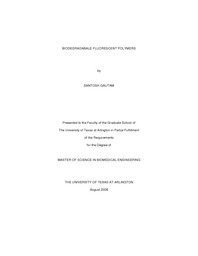
ATTENTION: The works hosted here are being migrated to a new repository that will consolidate resources, improve discoverability, and better show UTA's research impact on the global community. We will update authors as the migration progresses. Please see MavMatrix for more information.
Show simple item record
| dc.contributor.author | Gautam, Santosh | en_US |
| dc.date.accessioned | 2008-09-17T23:35:06Z | |
| dc.date.available | 2008-09-17T23:35:06Z | |
| dc.date.issued | 2008-09-17T23:35:06Z | |
| dc.date.submitted | July 2008 | en_US |
| dc.identifier.other | DISS-2205 | en_US |
| dc.identifier.uri | http://hdl.handle.net/10106/1092 | |
| dc.description.abstract | Most of the works done on fluorescent polymers are focused on their potential applications in lighting industries. Much less interest has been paid for their potential application in the field of biology and biomedical engineering. Although multiple biological uses of green fluorescent proteins (GFPs) have been addressed by different groups, their potential for biomedical applications is hampered by their tendency to photobleach rapidly and their short fluorescence lifetime. Quantum dots have emerged as a potential substitute for those applications, but their cytotoxicity and lack of biodegradability restrict their use in a biological system. An ideal fluorescent material that could be used for both biological and biomedical purposes should be biocompatible and biodegradable. They should have strong emissive property and high photostability.
The primary objective of this research was to develop biodegradable photolouminescent polymers (BPLPs) and nanoparticles using 1,8-Octanediol, Citric acid and different amino acids as the monomers. All of the twenty essential amino acids were used separately to create a family of BPLP. Owing to its better fluorescent properties, most of the experimental methods and discussion is based on BPLP with cysteine (BPLP-cys) in it. The
ratio between the monomers was also changed in order to fine tune the color and the mechanical properties of BPLPs. Different polymers and nanoparticles thus formed were characterized using fourier transformed infrared spectrometer (FTIR), nuclear magnetic resonance (NMR), ultra violet-visible spectrophotometer and fluorospectrophotometer. The tensile strength of BPLP-cys was found to be in a range of 3.2±0.13 to 6.5±0.8 MPa and its modulus was as high as 7.02±1.40 MPa. BPLP-cys had a maximum elongation up to 240±36 %. The results from transmission electron microscopy (TEM) indicated a size that ranged between 50 to 450 nm for various concentrations of BPLP-cys. The polymers were shown to be cytocompatible through various cell culture studies. Lastly, BPLPs incorporated with other amino acids emitted light in various regions of visible spectrum. Hence, the family of BPLP can prove to be helpful in multi-color imaging applications. | en_US |
| dc.description.sponsorship | Yang, Jian | en_US |
| dc.language.iso | EN | en_US |
| dc.publisher | Biomedical Engineering | en_US |
| dc.title | Biodegradable Fluorescent Polymers | en_US |
| dc.type | M.S.E. | en_US |
| dc.contributor.committeeChair | Yang, Jian | en_US |
| dc.degree.department | Biomedical Engineering | en_US |
| dc.degree.discipline | Biomedical Engineering | en_US |
| dc.degree.grantor | University of Texas at Arlington | en_US |
| dc.degree.level | masters | en_US |
| dc.degree.name | M.S.E. | en_US |
| dc.identifier.externalLink | https://www.uta.edu/ra/real/editprofile.php?onlyview=1&pid=1737 | |
| dc.identifier.externalLinkDescription | Link to Research Profiles | |
Files in this item
- Name:
- umi-uta-2205.pdf
- Size:
- 1.588Mb
- Format:
- PDF
This item appears in the following Collection(s)
Show simple item record


